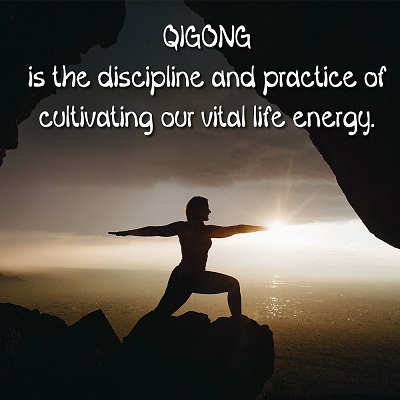 Qigong is an ancient practice from China that uses a combination of gentle movements, meditation, and sound that works to direct the energy from within. Qigong is pronounced as chee-gong; a combination of the words “qi” which is a traditional Chinese concept meaning vital life force, or energy, and “gong” which means mastery. Qi refers to the vital life force/vital energy in all of us.
Qigong is an ancient practice from China that uses a combination of gentle movements, meditation, and sound that works to direct the energy from within. Qigong is pronounced as chee-gong; a combination of the words “qi” which is a traditional Chinese concept meaning vital life force, or energy, and “gong” which means mastery. Qi refers to the vital life force/vital energy in all of us.
This energy sustains life and is the gatekeeper of our health. Gong refers to the daily practice or commitment involved in cultivating the mind and energy. Just like any discipline, this skill requires patience, practice, and time in order to be mastered. Through the powerful practice of Qigong, healing ourselves in a holistic manner is possible. This encompasses physical, mental, emotional, and spiritual dimensions of the body.
The Mind-Body Connection
The practice of Qigong acknowledges the mind and body connection and how it is possible to connect more deeply with our bodies through the mind. By cultivating the practice of Qigong, we are essentially unraveling the inner layers of the human body and making our connection with it known through the powerful force of our own emotions.
It is believed that the five organ systems that make up our bodies are more than just a physical dimension. They work together like a family, wherein they support one another and constantly communicate with each other. Through our emotions, we connect with these 5 bodily organ systems and transmit our energetic experience with them.
Our emotions are not just in our thoughts, but the energy of these emotions lives within our bodies and could get trapped inside. When one of our key organs is challenged, such as the liver, it has a direct influence on our emotions making us feel easily angered, frustrated, possibly more clouded in our judgments. This same qi causes us to get sick, feel stressed and often tired when it gets blocked inside our bodies.
When the body doesn’t trap qi inside, we feel vibrant and it affects us directly, too. That’s how feeling more alive, clear with purpose, and being easily motivated happens. The practice of Qigong releases any trapped energy inside our bodies, transforming us into more vibrant and healthy individuals. Cultivating qi is key to our longevity and good health. How happy and healthy we feel about life has a lot to do with the free flow of our qi (life force).
How Qigong Works
The role of Qigong is to unblock our qi, the vital life force, that sustains life. Qigong is the discipline and practice of cultivating this vital energy, perceiving this energy from within, and directing it through various techniques. These include controlled breathing techniques, meditations, movements, postures, and guided imagery, among others. It really is more of a movement meditation, than an exercise. A very popular type of Qigong is tai chi.
Qigong is practiced using the conscious mind. The conscious mind directs the body to relax while remaining in a state of awareness, remaining awake and alert. What makes it really powerful is the ability to put the body in a completely relaxed mode while one is awake. Our bodies effortlessly go into this relaxed mode only when asleep, but during Qigong, a person is powerfully awake and in a heightened state of consciousness.
When the body finally relaxes, all while remaining alert, the subject can direct the energy inside their body, enabling it to promote a well-balanced functioning in all parts of the body. As a result, Qigong effectively builds strength and stamina, similar to the experience of being in the gym without needing to exert a lot of physical force.
Qigong offers super-charged stress-relieving benefits. There are several types of Qigong styles around the world today, widely ranging in form and style; from meditation to more vigorous martial arts types of exercises. The more widely known type of Qigong – Tai Chi – effectively helps cultivate and manage qi.
Harnessing the effective power of Qigong to unblock our qi can be done through visualization and a heightened state of awareness. Self-healing is made possible with Qigong.
Qigong comes in many types. In fact, there are thousands of Qigong styles to choose from already, but they can be mainly categorized as Medical Qigong, Martial Qigong, and Spiritual Qigong. Generally, practitioners combine exercises encompassing all three categories, the only thing they differ mainly is in focus.
Medical Qigong is for self-healing and healing others, martial Qigong can be for heightened physical skill, and spiritual Qigong is for deeper enlightenment. Qigong sharpens the mind and focus intensely, all while making you feel superbly relaxed, as it builds up your strength from the inside. It rejuvenates the physical body and restores the inner balance.





